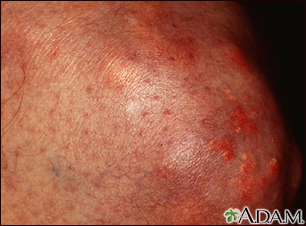Xanthoma
Definition
Xanthoma is a skin condition in which certain fats build up under the surface of the skin.
Alternative Names
Skin growths - fatty; Xanthelasma
Causes
Xanthomas are common, especially among older adults and people with high blood lipids (fats). Xanthomas vary in size. Some are very small. Others are bigger than 3 inches (7.5 centimeters) in diameter. They may appear anywhere on the body. But, they are most often seen on the elbows, joints, tendons, knees, hands, feet, or buttocks.
Xanthomas may be a sign of a medical condition that involves an increase in blood lipids. Such conditions include:
- Certain cancers
- Diabetes
- High blood cholesterol levels
- Inherited metabolic disorders, such as familial hypercholesterolemia
- Scarring of the liver due to blocked bile ducts (primary biliary cirrhosis)
- Inflammation and swelling of the pancreas (pancreatitis)
- Underactive thyroid (hypothyroidism)
Xanthelasma palpebra is a common type of xanthoma that appears on the eyelids. It usually occurs without any underlying medical condition.
Symptoms
A xanthoma looks like a yellow to orange bump (papule) with defined borders. There may be several individual ones or they may form clusters.
Exams and Tests
Your health care provider will examine the skin. Usually, a diagnosis can be made by looking at xanthoma. If needed, your provider will remove a sample of the growth for testing (skin biopsy).
You may have blood tests done to check lipid levels, liver function, and for diabetes.
Treatment
If you have a disease that causes increased blood lipids, treating the condition may help reduce the development of xanthomas.
If the growth bothers you, your provider may remove it by surgery or with a laser. However, xanthomas may come back after surgery.
Outlook (Prognosis)
The growth is noncancerous and painless, but it may be a sign of another medical condition.
When to Contact a Medical Professional
Call your provider if xanthomas develop. They may indicate an underlying disorder that needs treatment.
Prevention
To reduce the development of xanthomas, you may need to control your blood triglyceride and cholesterol levels.
Gallery




References
Dinulos JGH. Cutaneous manifestations of internal disease. In: Dinulos JGH, ed. Habif's Clinical Dermatology. 7th ed. Philadelphia, PA: Elsevier; 2021:chap 26.
Massengale WT. Xanthomas. In: Bolognia JL, Schaffer JV, Cerroni L, eds. Dermatology. 4th ed. Philadelphia, PA: Elsevier; 2018:chap 92.
White LE, Horenstein MG, Shea CR. Xanthomas. In: Lebwohl MG, Heymann WR, Berth-Jones J, Coulson IH, eds. Treatment of Skin Disease: Comprehensive Therapeutic Strategies. 5th ed. Philadelphia, PA: Elsevier; 2018:chap 256.